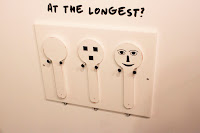When visiting the Bradford Media Museum for another project I happened across the current exhibition there called ' In Your Face' exhibiting from 23 July - 30 October 2016. This exhibit explored media or interactive pieces and how much information we get from faces.
are born as it is usually the first thing they look at. This makes babies good to study how adults read faces also. A test was created to get reactions from children using three panels. Each with different levels of characteristics of a face on. The results often found that the 'uncanny' variant of the panel being the least popular. Proving this is a natural occurrence even less self aware beings have.
It also stated that our brains are programmed to look for faces so much that we sometimes see a face that isn't really there such as in clouds or objects. This is called Pareidolia. Computers also pick up on this also which is why sometimes we end up with those terrifying face swap mishaps. An artist who used this to his advantage would be Shinseungback Kimyonghun who mounted a camera to the museum to look for faces in the sky. This used the computers face recognition program to register images of what it sees to be a face in the clouds. His work simply called 'Cloud Face'
I find it interesting that media has been adapted to pick up on human-like characteristics in the same way we do. I wonder if programs will be created that will also be able to distinguish 'fake' from 'real' in the same manner.

